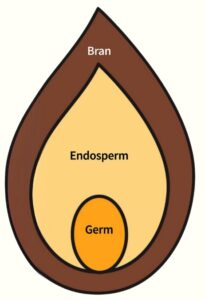What Is a Whole Grain Anyway?
go.ncsu.edu/readext?1071804
en Español / em Português
El inglés es el idioma de control de esta página. En la medida en que haya algún conflicto entre la traducción al inglés y la traducción, el inglés prevalece.
Al hacer clic en el enlace de traducción se activa un servicio de traducción gratuito para convertir la página al español. Al igual que con cualquier traducción por Internet, la conversión no es sensible al contexto y puede que no traduzca el texto en su significado original. NC State Extension no garantiza la exactitud del texto traducido. Por favor, tenga en cuenta que algunas aplicaciones y/o servicios pueden no funcionar como se espera cuando se traducen.
Português
Inglês é o idioma de controle desta página. Na medida que haja algum conflito entre o texto original em Inglês e a tradução, o Inglês prevalece.
Ao clicar no link de tradução, um serviço gratuito de tradução será ativado para converter a página para o Português. Como em qualquer tradução pela internet, a conversão não é sensivel ao contexto e pode não ocorrer a tradução para o significado orginal. O serviço de Extensão da Carolina do Norte (NC State Extension) não garante a exatidão do texto traduzido. Por favor, observe que algumas funções ou serviços podem não funcionar como esperado após a tradução.
English
English is the controlling language of this page. To the extent there is any conflict between the English text and the translation, English controls.
Clicking on the translation link activates a free translation service to convert the page to Spanish. As with any Internet translation, the conversion is not context-sensitive and may not translate the text to its original meaning. NC State Extension does not guarantee the accuracy of the translated text. Please note that some applications and/or services may not function as expected when translated.
Collapse ▲May is celebrated as National Mediterranean Diet Month. As a Family and Consumer Sciences agent with N.C. Cooperative Extension, one of our program offerings is a program highlighting the Mediterranean pattern of eating. We’ve just finished a series for the spring and are planning to offer another this fall. We thought we would take the month of May to share a few of the highlights of the Mediterranean diet or key takeaways from past participants.
To start off the month, we’re highlighting whole grains. Did you know the dietary guidelines recommend eating at least half of our grains as “whole grains”? Ever wondered what it really means for something to be whole grain? If you’ve ever participated in a workshop with me, you may know that I love math. That’s what finally made the idea of whole grains “click” for me.
If you’re thinking about the word whole- in general- how would you define it? When I ask summer campers or students in afterschool, their response usually has something to do with “the entire thing” or “all of the pieces.” Just like fractions tell us how many parts are in a whole, if something is a whole grain- it includes all of the pieces of the grain: the bran, the germ, and the endosperm.
Refined grains have been milled which is a process that removes the bran and germ. This process increases the shelf life of items, but it also removes dietary fiber, iron, and many B vitamins. Incorporating more whole grains into our diets helps provide that dietary fiber, iron, and vitamins that are absent in refined grains.
Whole grains are valuable sources of some antioxidants not found in fruits and vegetables, and people who regularly eat whole grains have a lower risk of many chronic diseases. If you’re looking to add more whole grains into your diet, consider incorporating popcorn, rye, wheat, rice, oats, barley, quinoa, or other grains that incorporate the entire grain kernel!
What if I’m reading a label that talks about refined or enriched grains? A refined grain refers to a grain that does not have all three key parts- so it is not a whole grain because it doesn’t have all the parts. White flour and white rice are two examples of a refined grain because both have had their bran and germ removed. This is why we recommend whole grains from a nutrition standpoint- the bran and germ offer more vitamins, minerals, and fiber than consuming the endosperm alone. Widespread removal of parts of the grain resulted in nutrition problems like pelagra and beri-beri. In response, many governments required companies to enrich these grains by adding back in missing nutrients.
Throughout the rest of the month we’ll be highlighting more nutrition topics like added sugar, saturated fat, and maybe sharing a recipe or two. For more information on the Mediterranean diet or upcoming Med Instead of Meds programming, visit go.ncsu.edu/duplin-mim or email rachel_ezzell@ncsu.edu.




